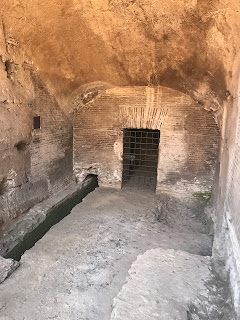did two things to help improve his people's feelings about the Roman government.
#1: He melted the face of Nero off the statue and replaced it with the face of Helios (god of the sun.)
#2: He began constructing the Colosseum as a gift to the Roman people. He wanted this to be a place where everyone could be entertained FOR FREE. It was supposed to be called The Flavian Amphitheater.
The structure itself is unbelievable. Pictures just don't do it justice, though I have included a few below. It is massive, beautiful, and strong. In the end, people began to call the amphitheater "The Colosseum" because they would meet to enter right where Nero's statue used to stand. I think that is a cool story!
Being inside The Colosseum, it's hard not to imagine the people who walked its corridors thousands of years ago. Check out the picture below of the place where a gladiator would have been held before being released to fight in front of the roaring crowd.
WOW!!!! Can you imagine waiting in this cell to fight to the death?
Something I didn't know is that there were two doors to the Colosseum used expressly by the gladiators. Once called the "Gate of the Dead" where anyone who died in battle was taken to be embalmed, cremated and buried. As much as Roman's loved to watch a good fight, they couldn't stomach seeing the gory remains of the the gladiators that didn't survive. The other door was called "The Gate of Victorious Living" and was where the survivors went on to be praised and glorified by the Roman people. Though they were slaves, they would receive a gold coin upon the completion of a successful battle from the emperor himself!
To this day, experts who study the Colosseum wonder where the emperor himself sat to enjoy the entertainment. There are two possible areas. One of them is closest to where his palace would have been on the Palatine Hill. Just about thirty years ago, a major discovery was made of a room/tunnel beneath this seating area decorated with frescoes and other artwork. Some say that if the emperor of the time was not very popular, he would take this fast route from his palace and pass the time in this private room before sitting for the games. These same experts think that a more popular and beloved emperor would have taken the longer route from his palace and paraded around the periphery of the Colosseum in order to please his people and soak up their cheering.
I find history so exciting and compelling because of what we can't know. It is a lot of fun to imagine just what things really would have been like so long ago.
More tomorrow!
Ciao!
Mrs. B.



Comments
Post a Comment